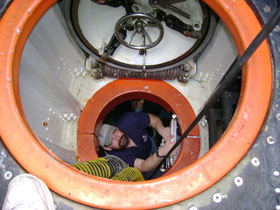  |
| HOME | THIS ISSUE | CALENDAR | GRANTS | BACK ISSUES | < BACK | NEXT > |
Archaeologists explore ocean floor for clues to early coastal settlementby Cindy Weiss - April 23, 2007 | ||||
| Anthropologists in the College of Liberal Arts and Sciences are identifying new sites to study archaeology that are fathoms, not feet, under the surface. Anthropology professor Kevin McBride and doctoral candidate David Robinson are scoping out early coastal human settlement sites, now under water, that could reveal clues to how the Americas were settled. McBride says early submerged sites may yield evidence of how the earliest coastal residents lived and how they got here. McBride, who is also director of research at the Mashantucket Pequot Museum and Research Center, was co-director and Robinson, a professional underwater archaeologist, one of the lead field archaeologists on a research expedition off Galveston, Texas, in March. During the week-long expedition, teams of scientists from several federal agencies and research institutions explored the submerged landscape around the Flower Garden Banks National Marine Sanctuary, 115 miles off the Texas-Louisiana coast in the Gulf of Mexico. The area, one of 13 U.S. national marine sanctuaries, was chosen because of its interesting geology and biology and its potential to contain preserved landforms with signs of some of America’s earliest inhabitants. The expedition used the U.S. Navy’s NR-1, the nation’s only nuclear-powered submarine dedicated to underwater research. The tools of exploration also included a remotely operated vehicle (ROV), and state-of-the-art “telepresence” technology that enabled scientists and educators on shore to track from thousands of miles away what was going on in the Gulf. McBride monitored the expedition from Mystic, along with co-director Robert Ballard, professor of oceanography at the University of Rhode Island and president of the Institute for Exploration at Mystic Aquarium. Looking for preserved elements of an old landscape, they surveyed 50-plus miles and found a six mile-long area about 300 feet under water that showed signs of what could be the intact remains of an old coastline and old river channels that would have led from shore to sea. It’s an area that holds promise for more detailed analysis, he says. At the height of the last glaciation, more than 20,000 years ago, the sea level was 350 to 400 feet lower than today, so what is now under water was then exposed land. The NR-1 is able to sink down and roll along the ocean floor on truck tires, allowing scientists to look out through portholes and visually examine features from only a few feet away. They could also map the sea floor with side-scan sonar while cruising 30-50 feet above the bottom. “We were essentially going for a walk on the sea floor in an area where there had been an old coastline,” says Robinson.
The area was too deep for scuba diving, but the researchers were able to use the sub and the ROV’s high-definition video camera and sub-bottom profilers to see above and below the surface of the sea floor, learning more about its features than if they were diving. McBride and Ballard monitored the work in real time, 24-hours a day, and produced 35 broadcasts for middle school students across the country. Robinson will introduce students to underwater archaeology during this summer’s UConn Archaeology Field School, which is managed by McBride. Robinson, who holds a master’s degree in shipwreck archaeology from Texas A & M University, is focusing his doctoral research at UConn on submerged settlements. His interest stems from work he has done during the past decade in Maryland and currently with the Public Archaeology Laboratory in Rhode Island. He has also traveled to Denmark several times during the past five years to work with some of the world’s experts in Stone Age underwater archaeology from the Danish National and Viking Ship museums. While McBride and Robinson are developing research opportunities in underwater archaeology, Nicholas Bellantoni, associate professor of anthropology and state archaeologist, is interested in the management and preservation of sites. Bellantoni hopes to explore the Long Island Sound for native sites in collaboration with UConn’s National Undersea Research Center (NURC) at Avery Point. With a rich maritime history, Connecticut is a prime place to explore offshore, he says. He expects there are probably hundreds, maybe thousands, of underwater archaeology sites, including shipwrecks, plane wrecks, and early Native American settlements in the Sound. Bellantoni says the prospects for underwater archaeology in Connecticut include tourism as well as science. He envisions creating “diver parks,” where recreational divers could visit and study historic shipwrecks. He is working with NURC on topographical maps and locating archaeological sites in the Long Island Sound. “We have not been able to pay enough attention to our submerged coastal resources,” he says. |
| ADVANCE HOME UCONN HOME |

